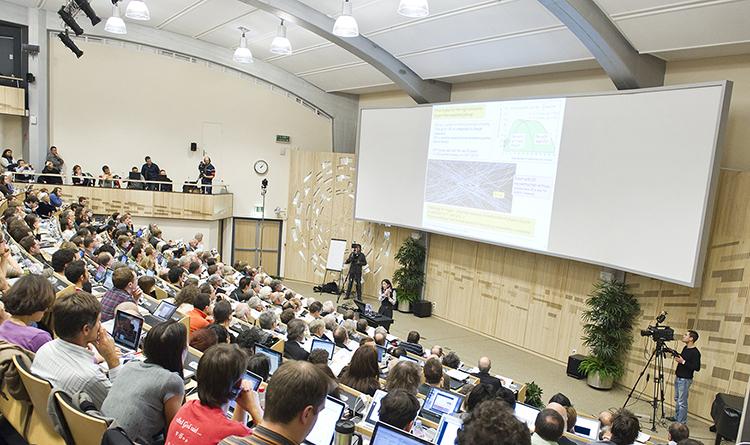Matrox Monarch H.264 Encoders Selected by CERN to Stream and Record the Latest Scientific Findings
By Jim Bask
Press Release
 (Montreal, Canada–June 13, 2018) The European Organization for Nuclear Research (CERN), sitting astride the Franco-Swiss border near Geneva, has been known for its ground-breaking discoveries in particle physics for over 60 years. CERN attracts some of the world’s leading scientists who probe the fundamental structure of the universe.
(Montreal, Canada–June 13, 2018) The European Organization for Nuclear Research (CERN), sitting astride the Franco-Swiss border near Geneva, has been known for its ground-breaking discoveries in particle physics for over 60 years. CERN attracts some of the world’s leading scientists who probe the fundamental structure of the universe.
CERN has grown to include 22 member states and, through the medium of science, contributes to the dialogue between nations. The center for particle physics research is home to some of the world’s largest and most sophisticated research equipment—such as the Large Hadron Collider (LHC), a 27-kilometer (16.77 miles) particle accelerator buried 100 meters (328 feet) underground on average, which has been instrumental in analyzing the way particles interact with one another.
Challenge
With 260 conference rooms, some of which were webcast-enabled, CERN needed to find a solution that provided the same experience to those watching abroad as the scientists watching in person. Marek Domaracky, senior video manager at CERN IT department, was seeking a dependable solution that would capture and deliver both the speaker and presentation material simultaneously. CERN had been using a PC, two capture cards, an encoder, and additional control software to share seminars online via video conference. However, this setup was both cumbersome and at times unreliable. Wanting to simplify the streaming process, they needed a standalone appliance, capable of independently starting and stopping streaming and recording.
Since CERN holds back-to-back lectures on a regular basis, a continuous webcast was required to avoid disconnecting viewers during the downtime between presentations. Looking to make their presentations more accessible to their worldwide audience, Domaracky wanted a reliable and flexible solution that would allow them to minimize the hardware in their setup.
Solution
Domaracky tested several solutions before deciding on the Matrox® Monarch HD H.264 encoder appliance. None of the other tested solutions could maintain an uninterrupted stream, while at the same time starting and stopping recordings. Monarch HD enabled CERN to independently start and stop recordings while maintaining the live stream. This allowed recordings to only capture the presentation itself and not the setup and transition between speakers.
Auditoriums are equipped with two Monarch HD appliances, each connected to a switcher via HDMI. Some of the auditoriums have an SDI camera; in those cases they are hooked up to a Monarch HDX unit, capable of accepting signals from HDMI or SDI sources. In both cases, a mixer is used to control the volume of all the presenters’ microphones. Output from the mixer is then sent to the speakers in the auditorium and a second output is sent to Monarch’s analog stereo input.
Monarch HD’s API (Application Programming Interface) was essential because it allowed CERN integrators to develop a web interface to control recording operations remotely. “For us, remote management was key,” explained Domaracky. “There can be two-to-three webcasts taking place at the same time and not enough technicians to be present in every room. The Matrox API allowed us to create a solution to this problem.”
From a remote office, an operator observes the live webcasts throughout the day, and determines when to start or stop the recordings via the API-based web interface. The Monarch appliances push daily webcasts in RTMP to a Wowza™ Media Server installed at CERN, while high-profile events are sent to the Limelight Networks® Content Delivery Network (CDN) to reach larger online audiences.
Through the API, Monarch was set up to record conferences directly to a shared storage on the local network. When lectures are conducted off site, they are saved to an attached USB storage and transferred to the network at a later time. Recordings are then uploaded to CERN’s unique, in-house developed video portal, which gives viewers control over watching full screen of the presenter, the lecture notes, or a side-by-side view.
Results
Thousands of worldwide viewers can tune into any live webcast, such as the announcement of the Higgs boson discovery, which earned the scientists who proposed its existence the 2013 Nobel Prize in Physics. This webcast yielded 50,000 views simultaneously and almost a million views on demand.
“Matrox Monarch encoders have helped us to continue and improve on our mission of furthering knowledge both within the scientific community and the general public,” Domaracky said. “We have a very thorough selection process and the Matrox products met our stringent requirements both in terms of specifications and cost.”
# # #
About Matrox Video
Matrox Video is a technology and market leader in the field of 4K and HD digital video hardware and software for accelerated H.264 encoding, streaming, A/V signal conversion, capture/playout servers, channel-in-a-box systems, and CGs. Matrox’s Emmy award-winning technology powers a full range of multi-screen content creation and delivery platforms used by broadcasters, telcos, cable operators, post-production facilities, live event producers, videographers, and A/V professionals worldwide. Founded in 1976, Matrox is a privately held company headquartered in Montreal, Canada. For more information, visit www.matrox.com/video.

